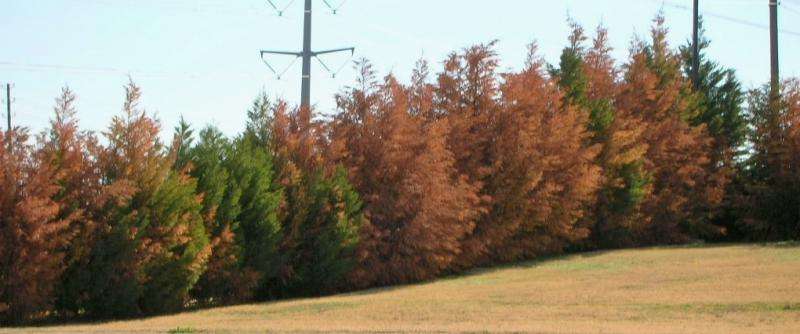Juniper and cypress varieties hit hard by blight

It's been a tough 2017 so far for juniper and cypress varieties used in landscapes, as pests and diseases make the rounds, causing blight and tree die-offs.
Kevin Ong, Texas A&M AgriLife Extension Service plant pathologist and director of the Texas Plant Disease Diagnostic Laboratory in College Station, said there are several different possible disease or pest issues plaguing juniper and cypress varieties around the state, from the Gulf Coast to Central, North and East Texas.
Complaints and questions have surrounded symptoms including brown dying trees, foliage that looks grayish brown, one side of the tree is dead, brown patches in the tree and many more, Ong said.
Ong said weather has played a significant role in pest and disease problems that have progressed over the past two months.
"We're seeing a lot of funky symptoms," he said. "Diagnosis have ranged from specific fungal diseases to pests or a combination of things."
The warm winter may have allowed spider mites to emerge much earlier than normal, he said. In a typical year, spider mites can become a summertime issue, but this year there were reports of infestations in early March.
Spider mites feed on trees, weaken them and expose them to pathogens, causing the dead brown patch appearance on trees, Ong said.
Two freeze events following warm conditions also may have damaged the actively growing trees, he said. The freezes may have opened spots for pathogens, such as various fungal canker pathogens, to enter and infect trees.
Significant rain events may also have drowned trees after root systems became waterlogged, Ong said. Wet soils can also predispose the tree to Phytophthora root rot, which can lead to dead trees.
Ong suspects Seiridium canker is one of the main culprits, though he did say multiple fungal diseases have been identified in trees. This canker causes branch dieback, resulting in an unsightly tree. Another common fungal disease that is observed is Botryosphaeria canker, which causes somewhat similar symptoms to seiridium canker.
There are no effective chemical controls available for these fungal canker diseases, Ong said. The best way to avoid canker is to help the tree avoid stresses. Prune out infected twigs and branches. Be sure to sterilize the pruning equipment with bleach following each cut. If the canker occurs on the trunk, consider removing the tree.
"We're getting a lot of questions, mostly from people utilizing these varieties for landscaping, because they are seeing changes in their plants," he said. "It's hard to explain when so many things are happening, but it hasn't slowed down and I don't expect it to slow down."
More information: For more information, go to the www.facebook.com/TXPlantClinic
Provided by Texas A&M University


















